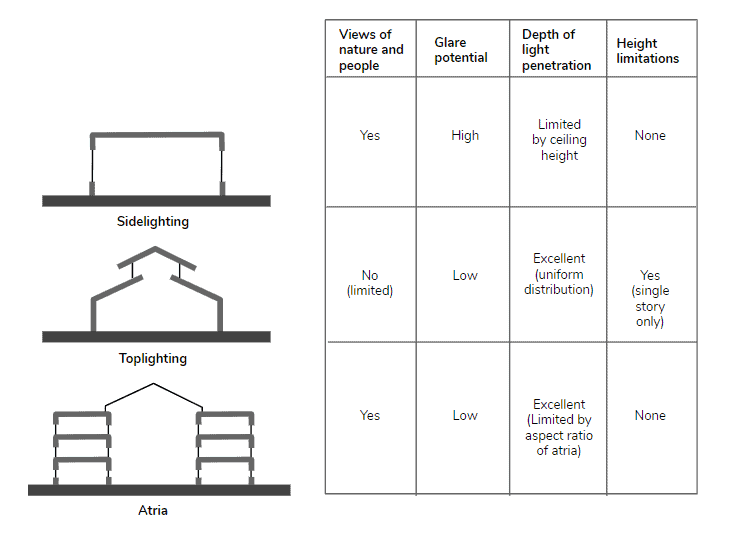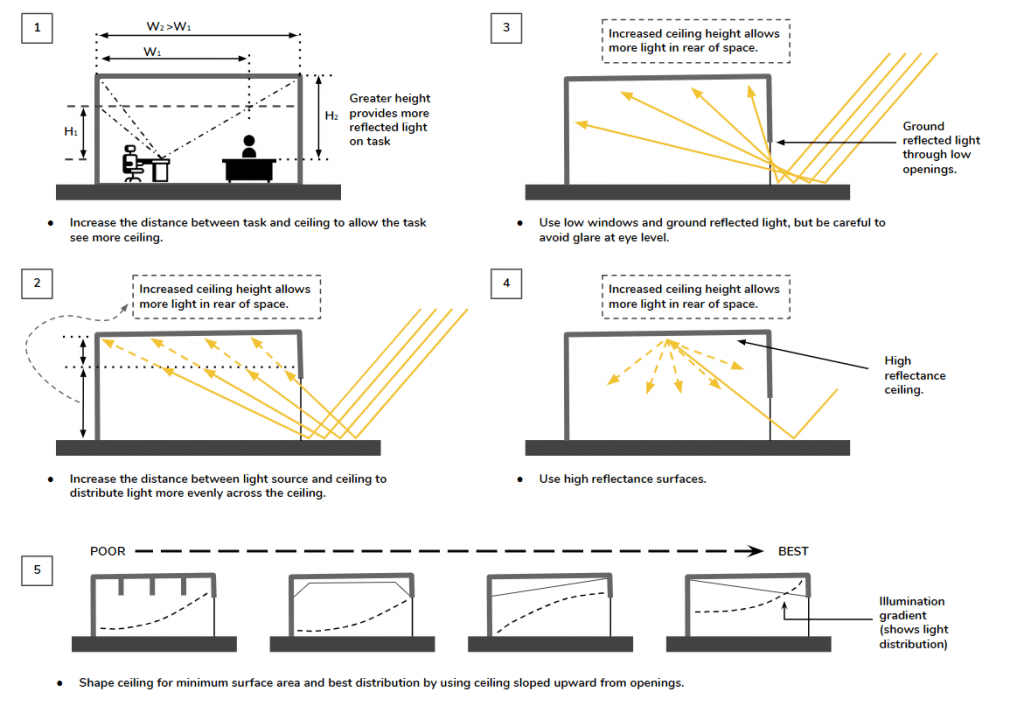
Sidelighting & Openings
Building shape and massing
The massing of a building determines the quality of light distribution. In general, narrow forms with greatest access to exterior openings will be easiest to illuminate with natural light. Before electric light was common, buildings were narrow, only as wide as they could be illuminated.
There are three basic forms for admitting natural light into a space: side lighting, top lighting or atria, as described below.

Sidelighting
The term side sighting describes the location of the opening. However, effective use of natural light requires more than a window. Light-reflectingand light-receiving surfaces must be integrated into the architecture to avoid glare and excessive heat gain.
In most cases, the ceiling will be best surface to receive reflected light. It should be unobstructed, high-reflectance, and shoıld be able to seen by task areas in a space.
See the following graphics, how to use the ceiling best to advantage.

Openings
Locate openings carefully because location affects both light distribution and the perception of distribution. A window wall can be horizontally divided into an upper third, middle third, and lower third. Each section has its distinct characteristics.
Upper section
The upper window sees brighter zenith of overcast sky and therefore has the best distribution of light on overcast days.For sunny conditions , the upper window does not provide the best light distribution. In any weather condition, an unbaffled upper window has great potential for sun and sky glare. Because the high window is often located above eye level, when properly baffled, the high window can admit very bright light without glare.
Middle section
The middle window is not optimal for light distribution on sunny days or overcast days, yet it is the most commonly used location because of the view afforded. Be careful to avoid glare from bright window sills and reflections in video display terminal screens from middle windows.
Lower section
The lower window provides optimal distribution of reflected sunlight. This is because it maximizes the distance between the light source and ceiling and provides greatest uniformity. Light levels will be lower near the window wall and higher deep in the space.
In practice, the upper, middle, and lower windows are often combined, and it is important to recognize that in the sunny condition, locating the opening as low as possible will result in most uniform distribution.
Multilateral openings
Locating the openings in more than one wall will enhance the distribution of light. With sidelighting in only one wall (unilateral), large amounts of light must be admitted to provide light deep in buildings. Because of this, there is a tendency for the area near the window to be underlit and perceived gloomy. Daylight openings on opposite or nearby walls of a space will provide more even distribution of light, brighten dark areas and allow usage of smaller windows with less over lighting.

Displacement
Projecting lower sills form a large glazing area similar to a greenhouse. This configuration will maximize illumination from area sources such as overcast skies. It can be used at orientations aht do not require shading.
The reverse is the overbite configuration , in which the window header extends over the lower sill. Like overhangs, it is best for ground-reflected sunlight and shades direct sun and skylight.
Follow us on our next article “ Sunlight Shading & Redirecting devices ”.
Sources;
Architectural Lighting by M. David Egan and Victor W. Olgyay
Office Address
Ofis In Maltepe Business Center,
Aydinevler Mah. Durak Sk No:3,
A/2, 34854 Maltepe,
Istanbul, Turkey
planlux@planlux.net
+90 216 327 37 77
Opening Hours
Monday — Friday 09am – 6pm
Saturday — Closed
Sunday — Closed
Philosophy
“We guide you to work with light. ”
Office Address
Ofis In Maltepe Business Center,
Aydinevler Mah. Durak Sk No:3,
A/2, 34854 Maltepe,
Istanbul, Turkey
planlux@planlux.net
+90 216 327 37 77
Opening Hours
Monday — Friday 09am – 6pm
Saturday — Closed
Sunday — Closed
Philosophy
“We guide you to work with light. ”
You will now be asked to fill a short form to share information for us to reach you.
Planlux takes this obligation seriously to protect the personal data that we collect, use, share, and process.
When you apply, you are deemed to have accepted our PRIVACY NOTICE that tells you what to expect when you provide information.
GO!
You will now be asked to fill a short form to share information for us to reach you.
Planlux takes this obligation seriously to protect the personal data that we collect, use, share, and process.
When you apply, you are deemed to have accepted our PRIVACY NOTICE that tells you what to expect when you provide information.
GO!


